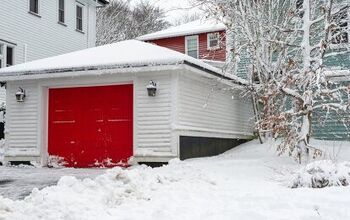Can I Use Interior Stain Outside?

Your home features beautiful wood detailing and furniture, but wood can look worn down over time. If you want to revive your wooden staircase or crown molding, an interior stain can help.
What if you want to restore your deck flooring? You may wonder, “Can wood stain be used outside?”
Yes, you can use interior stain outside, but it is generally not recommended. Interior stains are not formulated to endure weather conditions like rain, snow, or harsh sunlight. Interior stains are typically not treated with pesticides or fungicides either. This means if you only use interior stain on your deck, you’ll probably need to reapply the topcoat layer frequently.
It’s important to know the difference between interior and exterior stains plus when to use each one. This knowledge can help you keep your wooden furniture and fixtures in top shape.
Do You Need Exterior Home Paint or Stain Services?
Get free, zero-commitment quotes from pro contractors near you.

What Is Interior Stain Used For?
Interior stain is used for various items and detailing.
Furniture
- Kitchen cabinets
- Dressers
- Desks
- Tables
- Chairs
Home Woodwork
- Window trim
- Beams
- Crown molding
Doors
Interior stains can be applied to doors and door frames. This creates a cohesive look even if the types of wood used throughout your home are different.
Floors
Staining wood floors brings out their natural grain and mimics certain wood types.
What Are the Different Types of Stain?
Interior stains differ by their carrier (base), dye, and pigments. The carrier refers to whether a stain is oil-based or water-based. Other components may include resins and additives.
Oil-Based
Stains with an oil base are popular. They provide an even finish, are durable, and soak through deeply.
One drawback with oil-based stains is you need to prep surfaces beforehand. Necessary steps include stripping old paints or stains and sanding and polishing.
Water-Based
Stains with a water base dry quickly and are easy to work with. Homeowners who choose water-based stains do so because of the stain’s ability to resist mildew and mold.
Water-based stains typically contain less pigment, but you can achieve a darker shade by applying multiple coats. A common complaint with water-based stains is you have to work fast when using them.
Varnish
Applying varnish is the last step when staining wooden surfaces. Varnish contains a resin that boosts furniture’s defenses against moisture and dirt.
It’s ideal for smaller items that are already varnished or stained.
Gel
Gel-based stains are thick. This semi-solid state makes them easy to work with. The pigments don’t flow or run off as you apply the stain.
Gel stains are suitable for various woods (especially pine) since they can penetrate most surfaces. Gel-based stains dry slowly.
Water-Soluble Dye
Water-soluble dye (aniline dye) is available as a powder. Using it is simple — mix the pigment powder with water using the recommended ratio.
Water-soluble dye changes wood’s color without hiding its natural properties. It’s also easy to darken or lighten. Nevertheless, this stain is sensitive to UV light, including fluorescent bulbs.
Lacquer
Lacquer stains are best if you want a stain that dries quickly — as short as 15 minutes. Additionally, lacquer’s consistency is so thin, you’ll need fewer coats. The difficulty with lacquers is that they often leave bubbles.
Clear Topcoat Only
If you’re happy with how a certain wood grain looks, you may only want a clear topcoat. This “stain” doesn’t imbue color on wood surfaces. It’s ideal for furniture that gets a lot of use like dressers and tables.
You can apply a topcoat for other fixtures you stained, including floors.
What Is the Difference Between Interior and Exterior Stain?
Here are the main difference between interior and exterior stains.
Interior Stain
- Requires Protective Topcoat
- Requires Sanding Before Application
- Generally Safer
- Clear Finish
Exterior Stain
- Can Withstand the Elements
- Can Help Repel Insects or Rodents
- Changes Wood Color
What Stain Is Best For Outdoors?
The best stain for outdoors is the one treated to resist mold, water damage, and sunlight.
Generally, water-based stains fight off mold and mildew better, yet they are less long-lasting and durable overall. Oil-based stains last longer, but they are more prone to mold and water damage.
What Factors to Consider When Choosing an Exterior Stain
When picking out stains for outdoor use, keep these qualifiers in mind.
- Opacity: Do you want to showcase or hide your wood grain? Choose from semi-transparent, semi-solid, and solid/opaque stains.
- Location Relative to Sunlight and Moisture: Some stains are better suited to combat water and sun damage. Determine whether your deck touches moisture-attractive surfaces like concrete.
- Risk of Pest Infestations: Some stains offer more protection against species like bees, ants, termites, and beetles.
- Rainfall Patterns: If your area gets a lot of rain, consider stains with strong water-repellent properties.
- What Look You’re Going For: Do you prefer a darker-looking stain or a lighter one? Your aesthetic vision will sway your final decision.
- Wood Type: Softwoods (e.g. cedar, pine, redwood) are ideal for oil-based stains. Hardwoods (e.g. mahogany, teak, maple) are easier to treat using water-based stains.
This is because hardwoods dry slowly, so using oil-based stains is more challenging. Many hardwoods also already contain natural oils that help protect them from rot.
Do You Need Exterior Home Paint or Stain Services?
Get free, zero-commitment quotes from pro contractors near you.

Related Questions
Can you use interior stain on pressure-treated wood?
Yes. Most pressure-treated wood is used outdoors, but you can use interior stain on outdoor surfaces. Oil-based stains are a safe choice for pressure-treated wood.
What is the easiest stain to use?
Oil-based stains are beginner-friendly, but the easiest stain to use for you depends on the project.Do you need a wood stain that dries quickly? Do you prefer a stain that only requires one coat? Are you looking for a stain that accommodates mistakes?Answering these questions can help you identify the best stain for your project.
What is the difference between wood stain and wood finish?
A wood stain colors wood surfaces. Woodworkers and homeowners use stains to bring out wood’s inherent good looks.A wood finish is usually a clear coat that shields furniture, floors, or fixtures from moisture. Moreover, many people consider a stain a type of finish since stains also help protect surfaces.

We are a team of passionate homeowners, home improvement pros, and DIY enthusiasts who enjoy sharing home improvement, housekeeping, decorating, and more with other homeowners! Whether you're looking for a step-by-step guide on fixing an appliance or the cost of installing a fence, we've here to help.
More by Upgraded Home Team



























